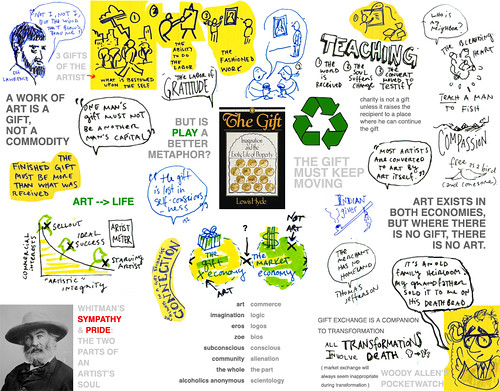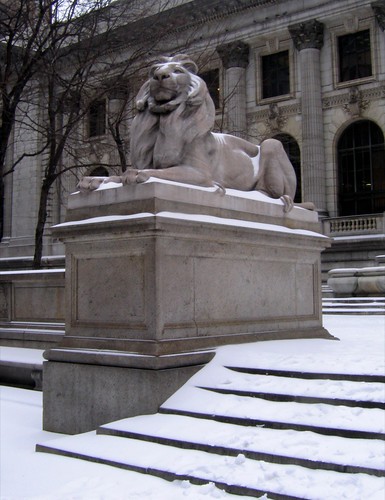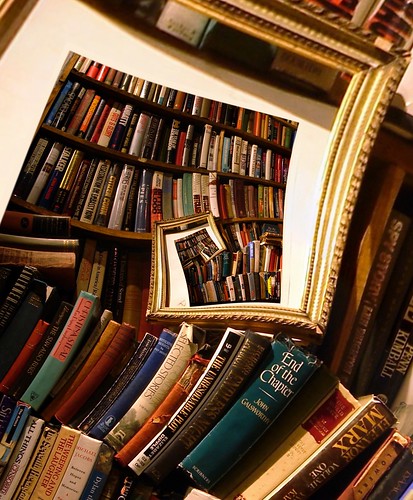I've been reading and digesting several thinkers/texts/thoughts on creativity -- and the genius of the cultural commons.
The individual genius is definitely a discredited idea these days.
Malcolm Gladwell addresses this issue in his May 2008 article,
"In the Air: who says big ideas are rare?" -- where he uses the example of
Nathan Myhrvold and his attempt to create a group capable of generating insights that might lead to scientific inventions and innovation. Gladwell asserts that "the genius is not a unique source of insight; he is merely an efficient source of insight."

Gladwell's latest book,
"Outliers: the story of success", similarly argues that those people who achieve extreme success owe a great deal to the fortuitous ecology of their lives. "They are products of history and community, of opportunity and legacy." And the success of late bloomers, like Cezanne, is highly contingent on the efforts of others surrounding and supporting them (he says in a New Yorker article on October 20, 2008,
"Late Bloomers: why do we equate genius with precocity?").
"For Innovators, There is Brainpower in Numbers" ran a recent article in the New York Times, affirming that "truly productive invention requires the meeting of minds from myriad perspectives, even if the innovators themselves don't always realize it." The article interestingly argues that brainstorming (or "idea showers" as some teachers I know prefer to call it -- eliminating that negative imagery), introduced in 1948, has been proved to be less effective than generally believed. Evidently, "individuals working alone generate more ideas than groups acting in concert". Instead, "systematic inventive thinking" is better, where successful products are analyzed into separate components and considered for alternative uses. "The best innovations occur when you have networks of people with diverse backgrounds gathering around a problem."
 Clay Shirky
Clay Shirky, professor of new media at New York University and author of
"Here Comes Everybody: the power of organizing without organizations", argues the same thing, especially in regards to the internet and Web n.0. (See
here and
here for videos of him presenting the ideas of the book.) He refers to the two kinds of social capital --
bonding capital, best envisaged as the number of people willing to lend you a large sum of money without asking when you'll be paying it back, and
bridging capital, the number of people to whom you would lend small amounts of money without much fuss. (In other words, bonding capital is more exclusive, bridging capital is more inclusive.)
Shirky asserts it's not how many people you know, it's how many different kinds of people -- that most good ideas come from people who are bridging "structural holes" in an institution -- because too much bonding capital in a group results in an echo-chamber of ideas. This is not creativity born of deep intellectual ability -- it's creativity as an import-export business.
Aside re school librarians: we are particularly well-suited to bring bridging capital (read: new ideas) to planning meetings, interacting as we do with all grade levels.
Gladwell, in an interview, also credits his own writing success with the breadth and diversity of his friendship base, when asked where he gets his ideas:
People tell me things. I have learned, I suppose, how to position myself to have access to serendipitous moments. I fill my life with people from diverse backgrounds. I have friends in academia, in business, in technology. Once you understand the importance of those contacts you can take steps to increase the likelihood of having them pay off. I never come up with things entirely by myself. It's always in combination with somebody. I exploit the entire resources of my friends very efficiently.
 Charles Leadbeater
Charles Leadbeater, a UK consultant on innovation and creativity, came out with a book similar to Shirky's at roughly the same time --
We-Think: mass innovation, not mass production. Videos of him speaking about the book can be found
here -- and there is a 3-minute animated illustration of the book on his
homepage. (I must admit, I like his plain confession,
This is Not a Blog.)
Leadbeater brings up
Lewis Hyde, poet, essayist, and author of
"The Gift", a book (first published in 1983) dedicated to exploring the gift economy, especially with regard to the arts, though also including the internet -- and the power of sharing and becoming aware of the gifts cycling throughout society. Hyde was recently the focus of a New York Times Magazine article --
"What is Art For?" -- in which he distinguishes his take on the artistic commons as more academic, abstract, and aesthetically nuanced compared with that of
Lawrence Lessig, founder and guru of the (more legalistic)
Creative Commons movement. (See Lessig's brilliant TED talk on
How Creativity is being Strangled by the Law.)

Hyde's book explores the concept of the gift economy (contrasted to the market/commodity economy), roaming through anthropology, mythology, and poetry (Walt Whitman and Ezra Pound, in particular) -- and likens it to our current understanding of ecology -- that every gift calls for a return gift in a large self-regulating earth system. He notes the traditional types of gifts -- separation gifts, threshold gifts or gifts of passage (birthdays, graduation, marriage, newcomers), and incorporation gifts (goodbye presents meant to give a piece of yourself to someone going away). Transformative gifts are less concrete, but no less important, and cover the situation of a young artist awakened to their life's labor by another's artistic gift to the world, with the paradox of the gift exchange -- that when a gift is used, it is not used up -- and how the only gratitude required is the act of passing the gift along. (I could go on and on -- read the book -- it's available from the
National Library for those of you in Singapore.)
Speaking of gifts -- look at this mindmap someone (
Austin Kleon) has put up on Flickr re Hyde's book:

It is obvious how this all relates to Web n.0. Here, for example, is a snippet about sharing from
a blog posting by
Mark Pesce, an Australian future-oriented consultant:
The center of this argument is simple, though subtle: the more something is shared, the more valuable it becomes. You extend your brand with every resource you share. You extend the knowledge of your institution throughout the Internet. Whatever you have – if it’s good enough – will bring people to your front door, first virtually, then physically.

Speaking of giving things away,
Seth Godin, major marketing guru, is giving away his most recent book, "Tribes" --
as an audio book. (I listened to it while doing housework one Sunday -- a perfect way to enhance menial tasks.)
His little book is about leaders -- and how tribes (the small units we're going to find ourselves belonging to) need them -- for the 7 C's: challenge, creating a culture, curiosity, communication, charisma, connection, and commitment. He defines leadership as the art of giving people a platform for spreading ideas that work. That leaders give people stories they can tell about themselves -- and that you can't lead without imagination (read: creativity).
Interesting aside: there's
a new social anthropology book out by Daniel Miller which argues that in London now every household is, in effect, a tribe.
Another free download (pass that gift on) to note:
Little Brother -- a popular young adult novel by
Cory Doctorow of
Boing Boing fame. Re the creativity of young people in evading Big Brother's attempt to control them and the internet.
Back to creativity: I must, of course, mention a few other TED talks on the subject: Sir Ken Robinson -- if people know any TED talk, it's usually this one:
Do Schools Kill Creativity? See also
Amy Tan -- and
Tim Brown.
I'm going to end with
Alison Gopnik, psychology/philosophy professor and child development expert and her musings on why fiction is so attractive to children (oops, humans) in the 2006
Edge "World Question Center".
The greatest success of cognitive science has been our account of the visual system. There's a world out there sending information to our eyes, and our brains are beautifully designed to recover the nature of that world from that information. I've always thought that science, and children's learning, worked the same way. Fundamental capacities for causal inference and learning let scientists, and children, get an accurate picture of the world around them - a theory. Cognition was the way we got the world into our minds.
But fiction doesn't fit that picture - its easy to see why we want the truth but why do we work so hard telling lies? I thought that kids' pretend play, and grown-up fiction, must be a sort of spandrel, a side-effect of some other more functional ability....
So the anomaly of pretend play has been bugging me all this time. But finally, trying to figure it out has made me change my mind about the very nature of cognition itself.
I still think that we're designed to find out about the world, but that's not our most important gift. For human beings the really important evolutionary advantage is our ability to create new worlds....
In fact, I think now that the two abilities - finding the truth about the world and creating new worlds-are two sides of the same coins. Theories, in science or childhood, don't just tell us what's true - they tell us what's possible, and they tell us how to get to those possibilities from where we are now. When children learn and when they pretend they use their knowledge of the world to create new possibilities. So do we whether we are doing science or writing novels. I don't think anymore that Science and Fiction are just both Good Things that complement each other. I think they are, quite literally, the same thing.






















